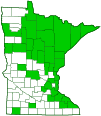Compton tortoiseshell
(Nymphalis l-album)
Conservation • Description • Habitat • Ecology • Distribution • Taxonomy
Conservation Status |
|
|||||||
| IUCN Red List | LC - Least Concern |
|||||||
| NatureServe | N5 - Secure S5 - Secure |
|||||||
| Minnesota | not listed |
|||||||
Description |
||
Compton tortoiseshell is a brush-footed butterfly. It occurs across in Europe, Asia, and North America. In Canada it occurs throughout the country but is most common in the southern half. In the United States it is mostly restricted to the northern third of the country, from Maine to New Jersey in the east to Washington in the West. In Minnesota it occurs in the northeastern two-thirds of the state but is most common in the Arrowhead region. It is found in coniferous, deciduous, and mixed forests, in orchards, and in suburbs. Compton tortoiseshell is a medium-sized butterfly but one of the largest brush-footed butterflies. Adults have a 2 9⁄16″ to 3 1⁄16″ (64 to 78 mm) wingspan. The margins of all four wings are jagged. The hindwings each have a small, tail-like projection. On the forewing the basal area is dark brown. The base color of the remainder of the forewing is rusty-orange to yellow. There is a black spot in the discal area and an S-shaped black band in the median area. In the post-medial area there are three black spots and also a black patch on the leading edge (costal margin). In the subterminal area there is a row of golden-yellow spots, a thin dark band, and a black patch at the wingtip (apex). A small white spot separates the black postmedial and subterminal patches. The hindwing is similar but with just two black patches separated by a white spot, no black spots, and a thin black subterminal line. The underside of both wings is mottled dark and light brown. There is a small silvery mark in the middle of the hindwing, but it is inconspicuous and easily overlooked if not searched for. |
||
Size |
||
Wingspan: 2 9⁄16″ to 3 1⁄16″ (64 to 78 mm) |
||
Similar Species |
||
Habitat |
||
Coniferous, deciduous, and mixed forests |
||
Ecology |
||
Season |
||
One generation per year: April through late May, late-June through July, and late August through late October. |
||
Behavior |
||
Larvae feed in groups |
||
Life Cycle |
||
Compton tortoiseshell is one of the first butterflies to be seen in early spring. Adults emerge from hibernation in late March to early April. They fly until late May, during which time they mate and the female lays small clusters of eggs on willow, poplar, and birch trees. When the eggs hatch the caterpillars feed on the leaves. Adults of the new generation emerge from late June to early July. They often estivate in mid-summer and become active again in September. In late October they hibernate in a hole in a tree or in a protected area on a building. |
||
Larva Food |
||
Leaves of willow, poplar, and birch trees. |
||
Adult Food |
||
Flower nectar, sap, and the juices of rotting fruit |
||
Distribution |
||||
|
7, 21, 24, 27, 29, 30, 71, 75.
|
|||
| 11/27/2021 | ||||
Occurrence |
||||
Common |
||||
Taxonomy |
|||
Order |
Lepidoptera (Butterflies and Moths) | ||
Superfamily |
Papilionoidea (butterflies) | ||
Family |
Nymphalidae (brush-footed butterflies) | ||
Subfamily |
Nymphalinae (checkerspots, anglewings, peacocks, and allies) | ||
Tribe |
Nymphalini (ladies, anglewings, and allies) | ||
Genus |
Nymphalis (tortoiseshells) | ||
Subordinate Taxa |
|||
Compton tortoiseshell (Nymphalis l-album j-album) Compton tortoiseshell (Nymphalis l-album l-album) |
|||
Synonyms |
|||
Nymphalis vaualbum |
|||
Common Names |
|||
Compton tortoiseshell False Comma |
|||
Glossary
Costal margin
The leading edge of the forewing of insects.
estivate
Enter a period of reduced metabolic activity in the summer, similar to hibernation.
visitor Photos |
|||||
Share your photo of this insect. |
|||||
| This button not working for you? Simply email us at info@MinnesotaSeasons.com. Attach one or more photos and, if you like, a caption. |
|||||
Sedna Cedarstone |
|||||
Just found up agains window inside. Temp outside 27. Will tuck it down in greenhouse. Can you ID please? Thanks |
|||||
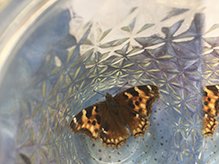 |
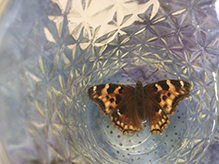 |
||||
MinnesotaSeasons.com Photos |
|||||
Upper Side |
|||||
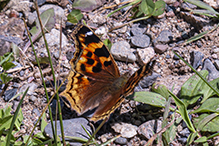 |
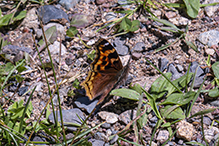 |
||||
Underside |
|||||
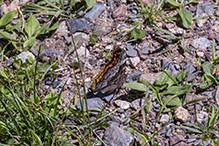 |
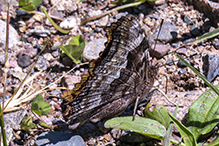 |
||||
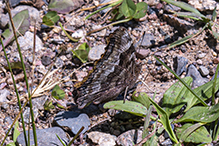 |
|||||

Slideshows |
||

visitor videos |
|||
Share your video of this insect. |
|||
| This button not working for you? Simply email us at info@MinnesotaSeasons.com. Attach a video, a YouTube link, or a cloud storage link. |
|||
Other videos |
|||
| 1000’s of Butterflies- Compton Tortoiseshell (Nymphalis vaualbum) Lake Superior Lycan |
|||
About
Aug 2, 2020 A crazy phenomenon at the best beach, perfect conditions and time of year must play a role in why there are thousands of beautiful Compton Tortoiseshell butterflies on the beach. I do a little slo-mo at the end of the video too. |
|||
| エルタテハ Nymphalis l-album /Nymphalis vaualbum 長野県烏帽子岳 2018/07/20 Eboshidake Nagano, Butterfly of Japan nonno |
|||
About
Jul 20, 2018 https://butterflynonno.net/index.html A Wild Butterfly Chase 蝶をめぐる冒険 長野県烏帽子岳 https://butterflynonno.net/20180720eboshidake.html Nymphalis l-album https://butterflynonno.net/f-erutateha.html Butterfly of Japan 日本の蝶 |
|||


Created: 11/27/2021
Last Updated:
